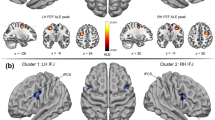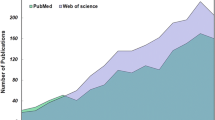Abstract
The right inferior frontal cortex (rIFC) is frequently activated during executive control tasks. Whereas the function of the dorsal portion of rIFC, more precisely the inferior frontal junction (rIFJ), is convergingly assigned to the attention system, the functional key role of the ventral portion, i.e., the inferior frontal gyrus (rIFG), is hitherto controversially debated. Here, we used a two-step methodical approach to clarify the differential function of rIFJ and rIFG. First, we used event-related functional magnetic resonance imaging (fMRI) during a modified stop signal task with an attentional capture condition (acSST) to delineate attentional from inhibitory motor processes (step 1). Then, we applied coordinate-based meta-analytic connectivity modeling (MACM) to assess functional connectivity profiles of rIFJ and rIFG across various paradigm classes (step 2). As hypothesized, rIFJ activity was associated with the detection of salient stimuli, and was functionally connected to areas of the ventral and dorsal attention network. RIFG was activated during successful response inhibition even when controlling for attentional capture and revealed the highest functional connectivity with core motor areas. Thereby, rIFJ and rIFG delineated largely independent brain networks for attention and motor control. MACM results attributed a more specific attentional function to rIFJ, suggesting an integrative role between stimulus-driven ventral and goal-directed dorsal attention processes. In contrast, rIFG was disclosed as a region of the motor control but not attention system, being essential for response inhibition. The current study provides decisive evidence regarding a more precise functional characterization of rIFC subregions in attention and inhibition.





Similar content being viewed by others
References
Aron AR (2011) From reactive to proactive and selective control: developing a Richer Model for stopping inappropriate responses. Biol Psychiatry 69:e55–e68
Aron AR, Poldrack RA (2006) Cortical and subcortical contributions to stop signal response inhibition: role of the subthalamic nucleus. J Neurosci 26:2424–2433
Aron AR, Robbins TW, Poldrack RA (2004) Inhibition and the right inferior frontal cortex. Trends Cogn Sci 8:170–177
Aron AR, Robbins TW, Poldrack RA (2014) Inhibition and the right inferior frontal cortex: one decade on. Trends Cogn Sci 18(4):177–185. doi:10.1016/j.tics.2013.12.003
Ashburner J, Friston KJ (2005) Unified segmentation. NeuroImage 26:839–851
Bari A, Robbins TW (2013) Inhibition and impulsivity: behavioral and neural basis of response control. Prog Neurobiol 108:44–79
Bissett PG, Logan GD (2014) Selective stopping? Maybe not. J Exp Psychol Gen 143:455–472
Boehler CN, Appelbaum LG, Krebs RM, Chen L, Woldorff MG, Wenderoth N (2011) The role of stimulus salience and attentional capture across the neural hierarchy in a stop-signal task. PLoS One 6:e26386
Brass M, von Cramon DY (2002) The role of the frontal cortex in task preparation. Cereb Cortex 12:908–914
Brass M, Ullsperger M, Knoesche TR, von Cramon DY, Phillips NA (2005) Who comes first? The role of the prefrontal and parietal cortex in cognitive control. J Cogn Neurosci 17:1367–1375
Bzdok D, Langner R, Schilbach L, Jakobs O, Roski C, Caspers S, Laird AR, Fox PT, Zilles K, Eickhoff SB (2013) Characterization of the temporo-parietal junction by combining data-driven parcellation, complementary connectivity analyses, and functional decoding. Neuroimage 81:381–392
Cai W, Leung H, Greenlee MW (2011) Rule-guided executive control of response inhibition: functional topography of the inferior frontal cortex. PLoS One 6:e20840
Chan AW, Downing PE (2011) Faces and eyes in human lateral prefrontal cortex. Front Hum, Neurosci 5
Chatham CH, Claus ED, Kim A, Curran T, Banich MT, Munakata Y (2012) Cognitive control reflects context monitoring, not motoric stopping, in response inhibition. PLoS One 7(2):e31546
Chikazoe J, Jimura K, Asari T, Yamashita K, Morimoto H, Hirose S, Miyashita Y, Konishi S (2009) Functional dissociation in right inferior frontal cortex during performance of go/no-go task. Cereb Cortex 19:146–152
Corbetta M, Shulman GL (2002) Control of goal-directed and stimulus-riven attention in the brain. Nat Rev Neurosci 3:215–229
Corbetta M, Patel G, Shulman GL (2008) The Reorienting system of the human brain: from environment to theory of mind. Neuron 58:306–324
Derrfuss J, Vogt V, Fiebach C, von Cramon D, Tittgemeyer M (2012) Functional organization of the left inferior precentral sulcus: dissociating the inferior frontal eye field and the inferior frontal junction. NeuroImage 59:3829–3837
Downar J, Crawley AP, Mikulis DJ, Davis KD (2001) The effect of task relevance on the cortical response to changes in visual and auditory stimuli: an event-related fMRI study. Neuroimage 14:1256–1267
Duncan J (2013) The structure of cognition: attentional episodes in mind and brain. Neuron 80(1):35–50
Eickhoff SB, Grefkes C (2011) Approaches for the integrated analysis of structure, function and connectivity of the human brain. Clin EEG Neurosci 42:107–121
Eickhoff SB, Laird AR, Grefkes C, Wang LE, Zilles K, Fox PT (2009) Coordinate-based activation likelihood estimation meta-analysis of neuroimaging data: a random-effects approach based on empirical estimates of spatial uncertainty. Hum Brain Mapp 30:2907–2926
Eickhoff SB, Jbabdi S, Caspers S, Laird AR, Fox PT, Zilles K, Behrens TEJ (2010) Anatomical and functional connectivity of cytoarchitectonic areas within the human parietal operculum. J Neurosci 30:6409–6421
Eickhoff SB, Bzdok D, Laird AR, Roski C, Caspers S, Zilles K, Fox PT (2011) Co-activation patterns distinguish cortical modules, their connectivity and functional differentiation. Neuroimage 57:938–949
Eickhoff SB, Bzdok D, Laird AR, Kurth F, Fox PT (2012) Activation likelihood estimation meta-analysis revisited. Neuroimage 59:2349–2361
Erika-Florence M, Leech R, Hampshire A (2014) A functional network perspective on response inhibition and attentional control. Nature Commun 5:4073
First M, Spitzer R, Gibbon M, Williams J (1996) Structured Clinical interview for DSM-IV axis I disorders, clinician version (SCID-CV). American Psychiatric Press Inc, Washington, DC
Floden D, Stuss DT (2006) Inhibitory control is slowed in patients with right superior medial frontal damage. J Cogn Neurosci 18:1843–1849
Fox PT, Lancaster JL (2002) Opinion: mapping context and content: the BrainMap model. Nat Rev Neurosci 3:319–321
Fox PT, Laird AR, Fox SP, Fox PM, Uecker AM, Crank M, Koenig SF, Lancaster JL (2005) BrainMap taxonomy of experimental design: description and evaluation. Hum Brain Mapp 25:185–198
Hampshire A, Chamberlain SR, Monti MM, Duncan J, Owen AM (2010) The role of the right inferior frontal gyrus: inhibition and attentional control. NeuroImage 50:1313–1319
Jakobs O, Langner R, Caspers S, Roski C, Cieslik EC, Zilles K, Laird AR, Fox PT, Eickhoff SB (2012) Across-study and within-subject functional connectivity of a right temporo-parietal junction subregion involved in stimulus–context integration. NeuroImage 60:2389–2398
Laird AR, Eickhoff SB, Kurth F, Fox PM, Uecker AM, Turner JA, Robinson JL, Lancaster JL, Fox PT (2009a) ALE meta-analysis workflows via the brainmap database: progress towards a probabilistic functional brain atlas. Front Neuroinform 3:23
Laird AR, Eickhoff SB, Li K, Robin DA, Glahn DC, Fox PT (2009b) Investigating the functional heterogeneity of the default mode network using coordinate-based meta-analytic modeling. J Neurosci 29:14496–14505
Laird AR, Eickhoff SB, Fox PM, Uecker AM, Ray KL, Saenz JJ, McKay DR, Bzdok D, Laird RW, Robinson JL, Turner JA, Turkeltaub PE, Lancaster JL, Fox PT (2011) The BrainMap strategy for standardization, sharing, and meta-analysis of neuroimaging data. BMC Res Notes 4:349
Laird AR, Eickhoff SB, Rottschy C, Bzdok D, Ray KL, Fox PT (2013) Networks of task co-activations. NeuroImage 80:505–514
Levy BJ, Wagner AD (2011) Cognitive control and right ventrolateral prefrontal cortex: reflexive reorienting, motor inhibition, and action updating. Ann N Y Acad Sci 1224:40–62
Logan GD, Cowan W, Davis K (1984) On the ability to inhibit responses in simple and choice reaction time tasks: a model and a method. J Exp Psychol Hum Percept Perform 10(2):276–291
Mazzola L, Faillenot I, Barral FG, Mauguiere F, Peyron R (2012) Spatial segregation of somato-sensory and pain activations in the human operculo-insular cortex. Neuroimage 60(1):409–418
Nichols T, Brett M, Andersson J, Wager T, Poline JB (2005) Valid conjunction inference with the minimum statistic. NeuroImage 25:653–660
Oldfield RC (1971) The assessment and analysis of handedness: the Edinburgh inventory. Neuropsychologia 9:97–113
Robinson JL, Laird AR, Glahn DC, Lovallo WR, Fox PT (2010) Metaanalytic connectivity modeling: delineating the functional connectivity of the human amygdala. Hum Brain Mapp 31:173–184
Rottschy C, Caspers S, Roski C, Reetz K, Dogan I, Schulz JB, Zilles K, Laird AR, Fox PT, Eickhoff SB (2013) Differentiated parietal connectivity of frontal regions for “what” and “where” memory. Brain Struct Funct 218(6):1551–1567. doi:10.1007/s00429-012-0476-4
Rouder JN, Speckman PL, Sun D, Morey RD, Iverson G (2009) Bayesian t tests for accepting and rejecting the null hypothesis. Psychon Bull Rev 16(2):225–237. doi:10.3758/PBR.16.2.225
Sebastian A, Pohl M, Klöppel S, Feige B, Lange T, Stahl C, Voss A, Klauer K, Lieb K, Tüscher O (2013) Disentangling common and specific neural subprocesses of response inhibition. NeuroImage 64:601–615
Sharp DJ, Bonnelle V, de Boissezon X, Beckmann CF, James SG, Patel MC, Mehta MA (2010) Distinct frontal systems for response inhibition, attentional capture, and error processing. Proc Natl Acad Sci USA 107:6106–6111
Swick D, Ashley V, Turken U (2011) Are the neural correlates of stopping and not going identical? Quantitative meta-analysis of two response inhibition tasks. NeuroImage 56:1655–1665
Tabu H, Mima T, Aso T, Takahashi R, Fukuyama H (2011) Functional relevance of pre-supplementary motor areas for the choice to stop during Stop signal task. Neurosci Res 70:277–284
Treede RD, Apkarian AV, Bromm B, Greenspan JD, Lenz FA (2000) Cortical representation of pain: functional characterization of nociceptive areas near the lateral sulcus. Pain 87(2):113–119
Turkeltaub PE, Eden GF, Jones KM, Zeffiro TA (2002) Meta-analysis of the functional neuroanatomy of single-word reading: method and validation. Neuroimage 16:765–780
Verbruggen F, Aron AR, Stevens MA, Chambers CD (2010) Theta burst stimulation dissociates attention and action updating in human inferior frontal cortex. Proc Natl Acad Sci USA 107:13966–13971
Wittchen H, Wunderlich U, Gruschwitz S, Zaudig M (1997) SKID-I. Strukturiertes Klinisches Interview für DSM-IV. Achse I: Psychische Störungen. Göttingen: Hogrefe
Acknowledgments
This work was supported by internal grants of the MAIFOR program and the research focus translational neurosciences (FTN) of the Johannes Gutenberg University Medical Center Mainz, Germany. Comprehensive access to the BrainMap database was authorized by a collaborative-use license agreement, provided to Simon Eickhoff by the University of Texas Health Science Center at San Antonio. BrainMap is supported by NIH/NIMH R01 MH074457. Findings presented in this study are part of the doctoral thesis of Jonathan Neuhoff.
Author information
Authors and Affiliations
Corresponding author
Additional information
A. Sebastian, P. Jung, O. Tüscher, A. Mobascher have contributed equally.
Electronic supplementary material
Below is the link to the electronic supplementary material.
Rights and permissions
About this article
Cite this article
Sebastian, A., Jung, P., Neuhoff, J. et al. Dissociable attentional and inhibitory networks of dorsal and ventral areas of the right inferior frontal cortex: a combined task-specific and coordinate-based meta-analytic fMRI study. Brain Struct Funct 221, 1635–1651 (2016). https://doi.org/10.1007/s00429-015-0994-y
Received:
Accepted:
Published:
Issue Date:
DOI: https://doi.org/10.1007/s00429-015-0994-y




